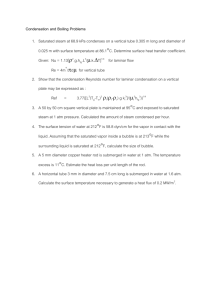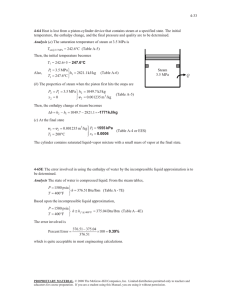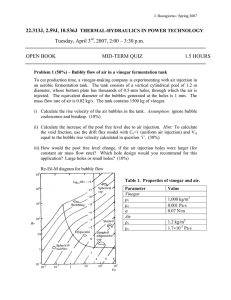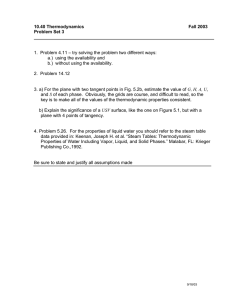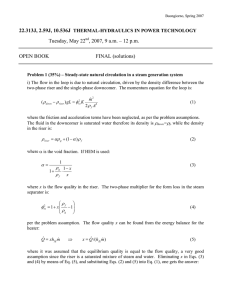Document 13600706
advertisement
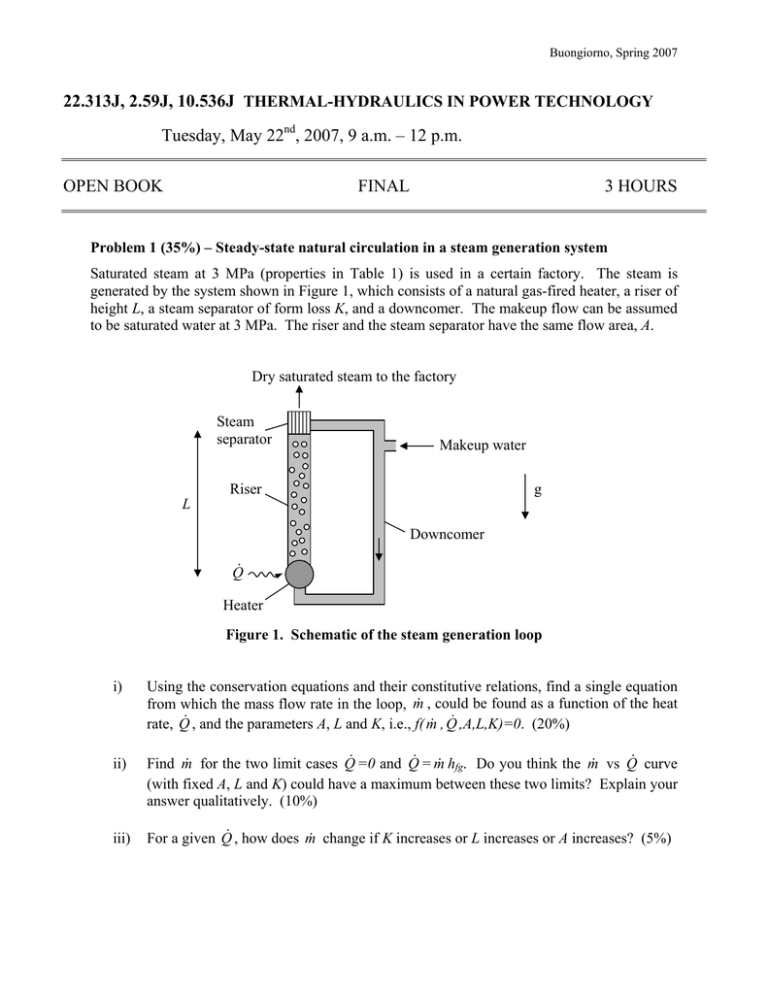
Buongiorno, Spring 2007 22.313J, 2.59J, 10.536J THERMAL-HYDRAULICS IN POWER TECHNOLOGY Tuesday, May 22nd, 2007, 9 a.m. – 12 p.m. OPEN BOOK FINAL 3 HOURS Problem 1 (35%) – Steady-state natural circulation in a steam generation system Saturated steam at 3 MPa (properties in Table 1) is used in a certain factory. The steam is generated by the system shown in Figure 1, which consists of a natural gas-fired heater, a riser of height L, a steam separator of form loss K, and a downcomer. The makeup flow can be assumed to be saturated water at 3 MPa. The riser and the steam separator have the same flow area, A. Dry saturated steam to the factory Steam separator Makeup water Riser g L Downcomer Q& Heater Figure 1. Schematic of the steam generation loop i) Using the conservation equations and their constitutive relations, find a single equation from which the mass flow rate in the loop, m& , could be found as a function of the heat rate, Q& , and the parameters A, L and K, i.e., f( m& , Q& ,A,L,K)=0. (20%) ii) Find m& for the two limit cases Q& =0 and Q& = m& hfg. Do you think the m& vs Q& curve (with fixed A, L and K) could have a maximum between these two limits? Explain your answer qualitatively. (10%) iii) For a given Q& , how does m& change if K increases or L increases or A increases? (5%) Buongiorno, Spring 2007 Assumptions: - Steady state - Steam separator efficiency is one - Use HEM for the void fraction in the riser - Neglect all acceleration and friction terms in the loop momentum equation ⎛ρ ⎞ - Use the HEM multiplier for the form loss in the separator, φl2o = 1+ x⎜ f −1⎟ ⎜ρ ⎟ ⎝ g ⎠ Table 1. Properties of saturated water at 3 MPa. Parameter Tsat ρf ρg hf hg Cp,f Cp,g μf μg kf kg σ Value 234°C (507 K) 822 kg/m3 15 kg/m3 1,008 kJ/kg 2,803 kJ/kg 4.7 kJ/(kg°C) 3.6 kJ/(kg°C) 1.1×10-4 Pa⋅s 1.7×10-5 Pa⋅s 0.638 W/(m°C) 0.047 W/(m°C) 0.030 N/m Buongiorno, Spring 2007 Problem 2 (55%) – Water boiling during a loss-of-flow transient in a home heating system A large condo building uses a water forced-convection heating system. The heater consists of hundreds of round channels of diameter D=2.54 cm and length L=1 m in which water is heated by an axially uniform heat flux, q″=200 kW/m2 (see Figure 2). The system operates at 1 MPa and the water temperature at the inlet of the heater channel is Tin=90°C (hin=365.6 kJ/kg). Under normal operating conditions the mass flux is Go=1000 kg/m2s and no boiling occurs in the channel. A pump malfunction occurs at t=0, so that the mass flux in the heater channel starts to decay exponentially, i.e., G(t) = Go e −t / τ , where τ =10 s. Assume that the heat flux, pressure and inlet temperature remain constant throughout the transient. q″ D G z Figure 2. A heater channel. Table 2. Properties of saturated water at 1 MPa. Parameter Tsat ρf ρg hf hg Cp,f Cp,g μf μg kf kg σ R* Value 180°C (453 K) 887 kg/m3 5.1 kg/m3 763 kJ/kg 2,778 kJ/kg 4.4 kJ/(kg°C) 2.6 kJ/(kg°C) 1.5×10-4 Pa⋅s 1.4×10-5 Pa⋅s 0.677 W/(m°C) 0.034 W/(m°C) 0.042 N/m 462 J/kg⋅K ∂h q"Ph = , ∂z A calculate the fluid enthalpy and equilibrium quality as functions of z and t. (5%) i) Using a simplified version of the energy conservation equation, G ii) At what time does the bulk temperature reach saturation? Assume the specific heat does not change with temperature. (5%) Buongiorno, Spring 2007 iii) At what time does nucleate boiling start? Use the Davis and Anderson model for ONB and assume that the single-phase forced convection heat transfer coefficient, H, G(t) , where Ho=9.3 kW/m2K. (10%) is proportional to the mass flux, i.e., H = H o Go iv) At what time does a significant amount of vapor first appear in the channel? (10%) v) Qualitatively sketch the MDNBR vs. time. (5%) vi) Qualitatively sketch the bulk and wall temperatures vs. time at the channel outlet. (10%) vii) Estimate the time at which two-phase density-wave oscillations appear in the channel. Use the stability map of Figure 3 below. (10%) Nsub Nsub=Npch - 4 Stable Unstable 2 0 6 12 Npch Figure 3. Stability map for the heater channel. Buongiorno, Spring 2007 Problem 3 (10%) – Short questions on bubble nucleation i) A steam bubble grows at a cavity with the geometry shown in Figure 4. What can you say about the steam temperature in this situation? (5%) ℓ v Figure 4. Steam bubble growing within a wall cavity. ii) To obtain bubble nucleation at a cavity of radius 1 μm on a copper surface, a certain fluid (of contact angle 135° with copper) requires a 2°C superheat. What would the required superheat be for bubble nucleation at a cavity of radius 3 μm on steel, if the fluid contact angle with steel were 45°? (5%)

